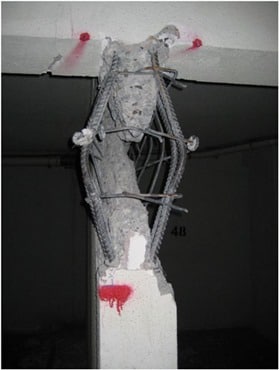أنشئ حسابًا أو سجّل الدخول للانضمام إلى مجتمعك المهني.

Excessive yielding and buckling of reinforcement occurs in severely damaged concrete structural members. The reinforcement may have buckled, elongated or excessively yielded in such members.
The causes for buckling and yielding of reinforcement in concrete structures occur due to unexpected application of loads for which the member was not designed or due to durability problems in concrete.
The unexpected load such as earthquake forces, increase in occupancy loads, heavy wind loads etc. Under such circumstances, the reinforcement in load bearing concrete members may buckle or yield.Buckling and yielding of reinforcement may also occur in structures as it gets old and durability problems such as corrosion of steel reinforcement which may have reduced the strength of concrete.
The repair of fractured, excessively yielded and buckled reinforcement can be done by replacing the damaged portion of steel reinforcement with new steel using butt welding or lap welding. Additional stirrup ties are added in the locations of damages and then jacket concreted to provide required confinement of concrete in the repaired zone and prevent future buckling of member.
Sometimes additional steel reinforcement will have to be anchored into existing masonry or concrete structural members. In such cases, a hole larger than the bar diameter is drilled. The hole is filled with grouting material such as epoxy, cement or other high strength grouting materials. The reinforcement bar is then pushed into place and held till the grout hardens.

Fig: Buckling of Reinforcement in RCC Column

Compressive Stress
Concrete is particularly resistant to compressive or vertical loads, which is why it is used widely in foundations. However, if the force falling on a concrete structure exceeds its maximum load, also known as critical force, it will cause the concrete to buckle under the weight. The critical load of a concrete column or structure is determined by its cross-section, the elasticity of the materials that compose it and the area over which the load is distributed.
Lateral Forces
Concrete may be good at withstanding vertical loads but it is comparatively vulnerable to lateral loads. That is why concrete structures are often reinforced with steel, which has complementary characteristics: weak on vertical loads, strong on lateral forces. If a concrete structure receives an extra lateral or horizontal load, it could buckle. This occurs often during earthquakes, which inflict huge lateral forces on buildings.
Changes in Heat
Materials expand and contract with heat and cold. That is why engineers design concrete structures with expansion joints that allow the structure to expand and contract without buckling. However, if expansion joints are not inserted, or if these expansion joints get filled in with foreign material, it could cause the concrete structure to buckle when the temperature increases. This often happens with concrete paving during the hot summer months.
Erosion
If a concrete structure is not protected from the erosive effects of the elements, such as water and acids, its structural integrity could be compromised, causing the entire structure to buckle and fall. This occurs in areas such as basements and foundations, where excessive water or moisture accumulates. Salt water is particularly dangerous to concrete buildings because it can also corrode the concrete's reinforcement bar.

I agree with Mr. Jaffer.

Thank you for invitation ...
I'm with your answer Eng.Jafar and i don't have any adds..


I am agree with brother Jafar

i agreed with Mr Alex

Agreed with both answers given by Mr. Jaafer and Mr. Alex

bulcking of concrete can also be when the mixture is poorly mesured eg if in1bag of cement you put thre7weelbarrow concrete can break
earthquakes can be anothercause

No Doubt with Answer of Engr. Jafar and Mr. Alex





هل تحتاج لمساعدة في كتابة سيرة ذاتية تحتوي على الكلمات الدلالية التي يبحث عنها أصحاب العمل؟